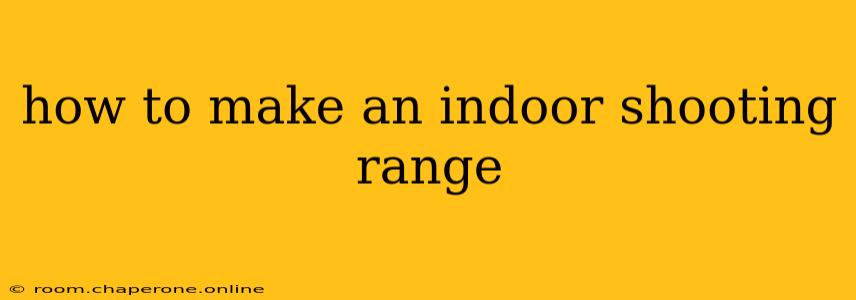Building your own indoor shooting range might seem daunting, but with careful planning and attention to safety, it's achievable. This guide provides a comprehensive walkthrough, covering everything from legal considerations to construction and maintenance. Remember, safety is paramount throughout this entire process. Improper construction can lead to serious injury or even death.
I. Legal Considerations: Navigating the Regulatory Landscape
Before you even think about buying a single tool, understand the legal ramifications. Regulations vary significantly by location (city, county, state, and country). You must research and comply with all applicable local, state, and federal laws regarding firearm ownership, storage, and the operation of a shooting range. This includes:
- Zoning Laws: Check your local zoning ordinances. Many areas have strict regulations on the use of firearms and the construction of structures for potentially hazardous activities.
- Building Codes: Your building will need to meet local building codes, especially regarding ventilation, fire safety, and structural integrity. This often requires professional consultation and permits.
- Firearm Licenses and Permits: Ensure you have all the necessary licenses and permits for firearm ownership and operation within your jurisdiction.
- Liability Insurance: Secure comprehensive liability insurance to protect yourself from potential lawsuits arising from accidents or injuries.
II. Designing Your Indoor Shooting Range: Safety First
The design of your indoor range is crucial for safety and effectiveness. Key considerations include:
A. Size and Layout: Optimizing Space and Safety
- Size: The minimum size depends on the types of firearms you intend to use and the number of shooters. Allow ample space for safe shooting distances, projectile stops, and maneuvering.
- Layout: Design the range to promote a clear line of fire, minimizing the risk of ricochets. Consider incorporating features like designated loading and unloading areas, separate storage for ammunition, and clear signage.
B. Backstop Design: Containing Projectiles
The backstop is arguably the most critical component. It must be capable of stopping projectiles safely and reliably. Options include:
- Bullet Trap: These specialized traps are designed to absorb the impact of projectiles. They are usually made of layered materials like steel, rubber, and sand.
- Earth Berm: While less common in indoor ranges due to space constraints, a well-designed earth berm can effectively stop projectiles.
C. Ventilation: Maintaining Air Quality
Shooting produces lead dust and other potentially harmful particles. Proper ventilation is critical to maintain a safe and healthy environment. Consider:
- Exhaust System: A powerful exhaust system is essential to remove contaminants from the air.
- Air Filtration: High-efficiency particulate air (HEPA) filters can further reduce airborne contaminants.
III. Construction: Building Your Range
This phase requires significant expertise and potentially professional assistance. Improper construction can render your range unsafe. Key aspects include:
- Foundation: Ensure a stable and secure foundation capable of withstanding the impact of projectiles.
- Walls and Ceiling: Use materials that can withstand projectile impacts.
- Lighting: Adequate lighting is vital for safety and visibility.
- Electrical Work: All electrical work should be performed by a qualified electrician to ensure compliance with safety regulations.
IV. Safety Equipment and Procedures
- Eye and Ear Protection: Mandatory for all shooters.
- Firearm Safety Rules: Strict adherence to firearm safety rules is non-negotiable.
- Emergency Procedures: Develop and practice emergency procedures for accidents or injuries.
V. Maintenance: Ensuring Long-Term Safety and Functionality
Regular maintenance is crucial to the long-term safety and effectiveness of your indoor shooting range. This includes:
- Backstop Inspection: Regularly inspect the backstop for any signs of damage.
- Ventilation System Maintenance: Regularly maintain and clean the ventilation system.
- Cleaning: Regularly clean the range to remove lead dust and other contaminants.
Building an indoor shooting range requires significant planning, investment, and expertise. Prioritize safety throughout the entire process. Consult with professionals, including architects, engineers, and firearm safety experts, to ensure compliance with regulations and the creation of a safe and effective shooting environment. Remember, this is not a DIY project to be taken lightly. Incorrect construction can result in serious injury or death.

